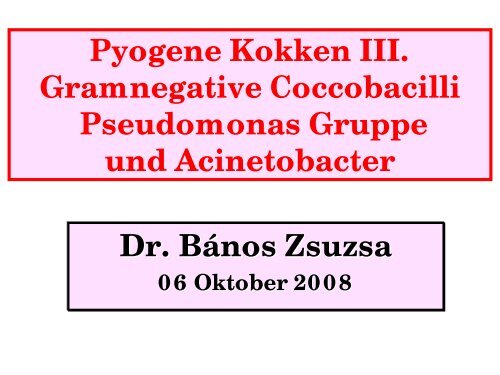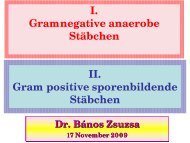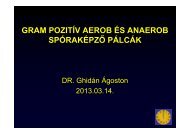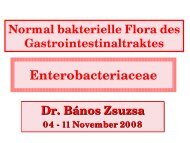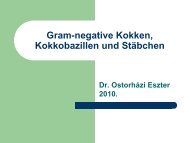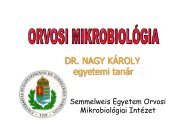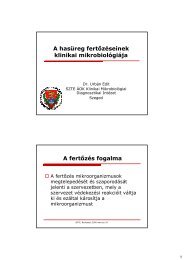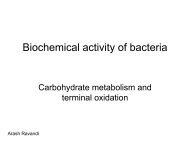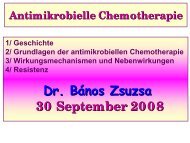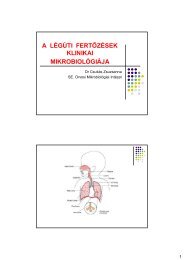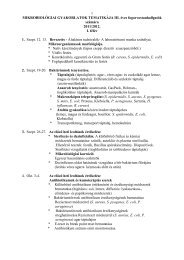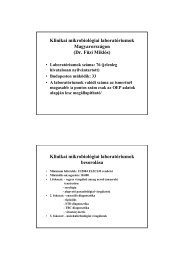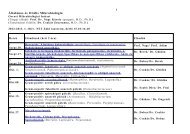Pseudomonas aeruginosa
Pseudomonas aeruginosa
Pseudomonas aeruginosa
Create successful ePaper yourself
Turn your PDF publications into a flip-book with our unique Google optimized e-Paper software.
Pyogene Kokken III.<br />
Gramnegative Coccobacilli<br />
<strong>Pseudomonas</strong> Gruppe<br />
und Acinetobacter<br />
Dr. Bános Zsuzsa<br />
06 Oktober 2008
Neisseria, Haemophilus,<br />
Bordetella<br />
1. Neisseria
Pyogene Kokken GRAM -<br />
Aerob: Oxidase +<br />
Neisseria N. gonorrhoeae P<br />
N. meningitidis P<br />
andere (N. sicca, N. subflava, N. flavescens und<br />
apathogene Arten)<br />
Moraxella M. catarrhalis<br />
Anaerob: Veillonella spp.<br />
Veillonellen vietsciences.free.fr
N. gonorrhoeae und N. meningitidis<br />
Morphologie<br />
Gramnegative<br />
Diplokokken<br />
www.waterscan.co.yu/images
Gramnegative Diplokokken<br />
path.upmc.edu
N. gonorrhoeae und N. meningitidis<br />
Kultur:<br />
Spezial Anspruchsvolle<br />
Bakterien<br />
Angereicherte Medien<br />
(Kochblutagar 5-10% CO 2 )<br />
Resistenz:<br />
Sind wenig resistent<br />
gegenüber Austrockung,<br />
Hitze, Desinfektionsmittel,<br />
Antibiotika<br />
Oxidase +<br />
path.upmc.edu
http://www.mfi.ku.dk/ppaulev/chapter33/images/33-3.jpg
N. gonorrhoeae = Gonococcus<br />
Antigene und Virulenzfaktoren:<br />
Pili/Fimbriae (Antigenvariationen!)<br />
IgA-Proteasen!<br />
outer membrane proteins (OMP)<br />
(Antigenvariationen!)<br />
LOS (Mimikri!)<br />
Zellwand Peptidoglycan (Toxische Wirkung)
N. gonorrhoeae = Gonococcus
N. gonorrhoeae = Gonococcus<br />
Pili<br />
textbookofbacteriology.net
N. gonorrhoeae = Gonococcus<br />
Gonococcus-Lymphozyt Interaktion<br />
neisseria.org/images/ng-lym2.jpg
N. gonorrhoeae = Gonococcus<br />
Infektionsquelle<br />
erkrankte Menschen<br />
Übertragung<br />
-Direkter (sexueller) Kontakt<br />
Krankheitsbilder<br />
Gonorrhea = Gonorrhö = Tripper<br />
Ophthalmoblenorrhea neonatorum<br />
Generalisation 1%<br />
KEINE IMMUNITÄT!<br />
(Antigenvarianten!)
Die Erreger des Trippers (Neisseria gonorrhoeae, hier blau)<br />
werden von fingerförmigen Fortsätzen auf der Zelloberfläche<br />
(grün) umschlossen. Im weiteren Verlauf der Infektion dringen<br />
die Bakterien dann in die Zelle ein.<br />
Max-Planck-Institut für Infektionsbiologie, Volker Brinkmann
Pathogenese<br />
Medmicro
Gonorrhea – akute Urethritis<br />
www.stdservices.on.net<br />
www.boltonlgb.co.uk
Gonorrhea – akute Urethritis
Gonorrhea – akute Cervicitis<br />
www.boltonlgb.co.uk
Gonorrhea – akute Cervicitis
Gonorrhea – akute Conjuctivitis<br />
Blenorrhea neonatorum<br />
www.mc3.edu<br />
Corneal ulcers due to<br />
gonococcus are very<br />
destructive and have a<br />
tendency to perforate the<br />
cornea.<br />
www.slackbooks.com
Gonorrhea – Kronische und disseminierte Formen<br />
Endometritis,<br />
Salpingitis,<br />
Prostatitis<br />
purulent Arthritis,<br />
Vasculitis<br />
Wichtig!<br />
anorectal Go und Pharyngitis<br />
(„alternative Genitalien”)
Fig. 8.33 Gonococcal<br />
septic arthritis. Arthritis<br />
due to N. gonorrhoeae in<br />
a 24-year-old woman,<br />
showing marked erythema<br />
and swelling of the right<br />
ankle and leg. By courtesy<br />
of Dr. T.F. Sellers Jr.<br />
Fig. 8.33 Gonococcal<br />
arthritis. Dactylitis<br />
secondary to gonococcal<br />
bacteriaemia. By courtesy<br />
of Dr. S.E. Thompson
Gonorrhea – Diagnose – nur bei akuten Krankheiten<br />
Mikroskopisch<br />
Nachweis des Erregers<br />
Gramfärbung<br />
www2.mf.uni-lj.si,<br />
www.uni-ulm.de,<br />
pathmicro.med.sc.edu<br />
Methylenblau Färbung, Direkt Immunoflueroscenz (DIF)
GO – Gramfärbung – nur vorherige Diagnose!
GO – Gramfärbung – nur vorherige Diagnose!<br />
www.med.uni-giessen.de
Gonorrhea – Diagnose<br />
Kultur:<br />
„bedside” Thayer-Martin medium<br />
und Kochblutagar, 5% CO2<br />
Identifizierung: ox+, glu+, mal-<br />
Antigennachweis:<br />
Latex-agglutination<br />
www2.mf.uni-lj.si,<br />
www.uni-ulm.de,<br />
pathmicro.med.sc.edu
Therapie:<br />
3. Generation Cephalosporin (Ceftriaxone)<br />
oder Spectinomycin (Aminoglycoside)<br />
Prophylaxe:<br />
GO<br />
- Vermeidung infektiöser Kontakte<br />
(safe sex)<br />
- Erfassung und Sanierung aller Infektionsquelle<br />
- Frühe Diagnose und Behandlung<br />
Ophthalmia neonatorum:<br />
Applikation von 1% Silbernitrat in Conjunctivasack<br />
Keine Schutzimpfung! (Antigenvarianten!)<br />
Gonorrhea<br />
www.tiscali.co.uk
N. meningitidis = Meningococcus<br />
scanning EM<br />
textbookofbacteriology.net
N. meningitidis = Meningococcus<br />
Antigene und Virulenzfaktoren:<br />
Kapsel – Polysaccharide<br />
12 Serotyp (A, B, C, W135, Y!)<br />
Pili/Fimbriae<br />
IgA-Proteasen!<br />
Outer Membrane Proteine (OMP)<br />
LOS (Mimkri, sialisiert ist Serum resisitent!)
Meningococcus<br />
zdsys.chgb.org.cn
N. meningitidis = Meningococcus<br />
Infektionsquelle<br />
Menschen – Keimträger (erkrankte, gesund)<br />
Übertragung, Eintrittspforte<br />
- Direkt, Tröpfcheninfektion<br />
- Nasen-, Rachenraum<br />
Krankheitsbilder<br />
Pharyngitis<br />
Meningitis cerebrospinalis epidemica<br />
Sepsis = Waterhouse-Friderichsen Syndrom
Fig. 10.56 Acute meningococcaemia. Note the variable size of the lesions and<br />
their peripheral distribution. Some of the lesions are obviously purpuric, others<br />
macular or papular.
Fig. 10.60 Acute meningococcaemia. Petechia on bulbar conjunctiva.
Fig. 10.62 Acute meningococcaemia. Gangrene of the extremities following a<br />
near-fatal illness with hypotension.
Fig. 10.63 Acute meningococcaemia. Gangrene of both legs in a black man<br />
with acute meningococcal infection. Bilateral below knee amputations were<br />
later required.
The characteristic skin rash of meningococcal septicaemia, caused by<br />
Neisseria meningitidis. (Courtesy of Wellcome Trust Photographic Library)<br />
srs.dl.ac.uk
Waterhouse – Friderichsen Syndrom - diagnose<br />
www.lboro.ac.uk
Waterhouse- Friderichsen Syndrome: schwere nekrotisierende<br />
Hautläsionen bei Meningokokkensepsis mit Verbrauchskoagulopathie<br />
(R. E. Rieger, Univ.-Kinderklinik Marburg).<br />
© Urban & Fischer 2003 – Roche Lexikon Medizin, 5. Aufl.<br />
www.gesundheit.de
The patient with Waterhouse-Friderichsen syndrome has sepsis<br />
with DIC and marked purpura.<br />
medlib.med.utah.edu
Purulent meningitis with hemorrhage in the frontal lobe (gross findings).<br />
pathy.fujita-hu.ac.jp
Acute hemorrhage in bilateral adrenals caused acute adrenal<br />
insufficiency (Waterhouse-Friderichsen syndrome).<br />
pathy.fujita-hu.ac.jp
Untersuchungsmaterialen:<br />
Liquor! - Lumbalpunction<br />
Blut<br />
Keimträger: Rachenabstrich<br />
Meningitis Diagnose
Meningitis Diagnose<br />
Nachweis des Erregers<br />
Mikroskopische Untersuchung<br />
(Liquor, Blutkultur)<br />
Kultur<br />
Liquor, Blut, Rachen<br />
Direkt Ag Nachweis<br />
(Liquor) – Latex-agglutination
Kultur: Blutagar,<br />
Kochblutagar<br />
Identifizierung:<br />
glu+, mal+<br />
MIC (E-test)<br />
Diagnose<br />
N. meningitidis
Meningococcus meningitis<br />
Therapie:<br />
Penicilline und/oder<br />
Cephalosporine (III. Gen.)<br />
Keine Beta-lactamase Bildung<br />
Prophylaxe:<br />
Aktive Immunisierung<br />
Schutzimpfung für:<br />
- Risikogruppen<br />
- Reisender<br />
(Meningitisgürtel!)<br />
Chemoprophylaxe:<br />
Rifampicin (Kontakte)
Meningitisgürtel
Neisseria meningitidis - B<br />
Europa!<br />
Keine Schutzimpfung!<br />
Rifampicin<br />
www.versapharm.com
Neisseria, Haemophilus,<br />
Bordetella<br />
2. Haemophilus
KLEINE GRAMNEGATIVE STÄBCHEN<br />
Gattung Art<br />
Haemophilus H. influenzae P<br />
H. parainfluenzae<br />
H. aegyptius P<br />
H. ducreyi P<br />
Bordetella B. pertussis P<br />
B. parapertussis<br />
P: Pathogen
Haemophilus influenzae<br />
Morphologie:<br />
Gram - Coccobacillus,<br />
ca. 1 μm<br />
Kultivierung:<br />
Wachstumsfaktoren !<br />
(Kochblutagar,<br />
X= Haem, V= NAD,<br />
Satellitenphänomen,<br />
„Ammenphänomen”)<br />
www.waterscan.co.yu/images
phil.cdc.gov<br />
Blood agar plate culture showing Haemophilus influenzae<br />
satelliting around Staphylococcus aureus.
Haemophilus influenzae<br />
Antigene und Virulenzfaktoren:<br />
Kapsel – Polysaccharid<br />
Typen: a, b, c, d, e, f (HiB!)<br />
IgA-Proteasen!<br />
Körperantigene:<br />
Outer Membrane Proteine (OMP)<br />
LPS
Haemophilus<br />
influenzae Typ b<br />
(Hib)<br />
www.soundmedicine.iu.edu
Haemophilus influenzae<br />
Krankheitsbilder:<br />
Meningitis, Sepsis<br />
Cellulitis<br />
Obere Luftwege:<br />
Epiglottitis!, Nasopharyngitis, Sinusitis, Otitis media<br />
Untere Luftwege:<br />
Bronchitis, Pneumonie,
Haemophilus influenzae<br />
Sepsis<br />
An infant with severe vasculitis with disseminated intravascular coagulation (DIC) with<br />
gangrene of the hand secondary to Haemophilus influenzae type b septicemia - prior to<br />
the availability of the Hib vaccine.<br />
-Image provided by: Visual Red Book on CD-ROM-<br />
www.ecbt.org<br />
-(2000 Red Book: 25th Edition, Report of the Committee on Infectious Diseases)
Haemophilus influenzae<br />
Periorbital cellulitis.<br />
© Neal Halsy, MD www.cispimmunize.org
Haemophilus influenzae<br />
Krankheitsbilder:<br />
Meningitis, Sepsis<br />
Cellulitis<br />
Obere Luftwege:<br />
Epiglottitis!, Nasopharyngitis, Sinusitis, Otitis media<br />
Untere Luftwege:<br />
Bronchitis, Pneumonia,
HIB-epiglottitis
Haemophilus influenzae<br />
Diagnose:<br />
Untersuchungsmaterial<br />
LIQUOR! (CSF)<br />
Proben aus Infektionsort (Nase, Rachen, Sputum etc.)<br />
Erregernachweis:<br />
Mikroskopie, Züchtung,<br />
Kapsel Ag detektion (Latex-agglutination)<br />
Therapie:<br />
1. Ampicillin + III. gen. Cephalosporine<br />
2. Ampicillin + Aminoglycoside<br />
Prophylaxe:<br />
Aktive Immunisierung - HiB Konjugat-Vakzine<br />
(Polysaccharide + Protein)
Lipopolysaccharid<br />
Extrakt - Vakzine<br />
ibs-isb.nrc-cnrc.gc.ca<br />
www.kmhk.kmu.edu.tw
Haemophilus ducreyi<br />
Krankheitserreger von Ulcus molle = Chancroid =<br />
= weicher Schanker<br />
Haemophilus aegyptius<br />
Krankheitserreger von Brasilianische Purpuric Fieber<br />
Haemophilus parainfluenzae<br />
Pharyngitis, Endocarditis, Konjunktivitis
Ulcus molle
Ulcus molle
medinfo.ufl.edu
Chancroid in female<br />
www.smu.edu
Neisseria, Haemophilus,<br />
Bordetella<br />
3. Bordetella
KLEINE GRAMNEGATIVE STÄBCHEN<br />
Gattung Art<br />
Haemophilus H. influenzae P<br />
H. parainfluenzae<br />
H. aegyptius P<br />
H. ducreyi P<br />
Bordetella B. pertussis P<br />
B. parapertussis<br />
P: Pathogen
Bordetella pertussis<br />
Morphologie:<br />
Gramnegative<br />
Coccobacillus,<br />
ca. 1 μm<br />
www.waterscan.co.yu/images
Bordetella pertussis<br />
Kultur:<br />
Spezial Medien<br />
Bordet – Gengou<br />
nobelprize.org<br />
www.szu.cz
Bordetella pertussis<br />
Antigene und Virulenzfaktoren:<br />
Kapsel<br />
Fimbriae, filamentöses Haemagglutinin<br />
Outer Membrane Proteine (OMP)<br />
LPS<br />
Pertactin<br />
Extrazelluläre Toxine:<br />
Pertussis Toxin<br />
Adenylatzyklase Toxin<br />
Tracheales Zytotoxin<br />
Dermatonekrotisches Toxin
FIGURE 31-2 Virulence factors of B pertussis.<br />
Medmicro
Pertussis toxin<br />
www.med.sc.edu:85
Bordetella pertussis<br />
Pathogenese, Infektion:<br />
Infektionsquelle: Kranke – in prodromalen und<br />
katarrhalischen Stadium<br />
Eintrittspforte: Respirationstrakt<br />
Übertragung: Tröpfcheninfektion → sensitive!<br />
55°C; 30’
FIGURE 31-1 Pathogenesis of whooping cough.<br />
Medmicro
www.my-pharm.ac.jp
FIGURE 31-3 Binding of pertussis toxin to cell membranes.<br />
Medmicro
FIGURE 31-4 Synergy between pertussis toxin and the<br />
filamentous hemagglutinin in binding to ciliated<br />
respiratory epithelial cells.<br />
Medmicro
Bordetella pertussis<br />
Krankheitsbild:<br />
Keuchhusten / Pertussis<br />
(Peribronchial Entzündung, Interstiziale Pneumonie)<br />
4-Phasen:<br />
Prodromalen,<br />
Katarrhalische,<br />
Paroxysmalen,<br />
Konvalescent<br />
Colonization of tracheal epithelial cells by B. pertussis web.umr.edu/~microbio
Pertussis –<br />
paroxysmale Phase<br />
www.gesundes-kind.de,<br />
www.vaccineinformation.org
www.med.sc.edu<br />
www.thecrookstoncollection.com<br />
Lymphozytose<br />
Pertussis - Diagnose<br />
aapredbook.aappublications.org
Bordetella pertussis<br />
Diagnose<br />
Kultur:<br />
Bordet – Gengou<br />
Direkt Anhusten!<br />
Charcoal Medium<br />
Serologie:<br />
IgM, IgA, IgG Nachweis<br />
PCR<br />
medinfo.ufl.edu
Bordetella pertussis<br />
Therapie:<br />
Makrolide<br />
Prophylaxe:<br />
Aktive Immunisierung – azelluläre Vakzine DaPT<br />
Toxoid<br />
FH/Pilus<br />
Pertactin
AEROB<br />
Bordetella<br />
Brucella<br />
Francisella<br />
GRAMNEGATIVE STÄBCHEN<br />
<strong>Pseudomonas</strong><br />
Acinetobacter<br />
Legionella<br />
FAKULTATIV ANAEROB<br />
Haemophilus<br />
Pasteurella<br />
Familie:<br />
Enterobacteriaceae<br />
Vibrionaceae<br />
Cardiobacterium<br />
Eikenella<br />
Kingella<br />
Actinobacillus<br />
ANAEROB<br />
Bacteroides<br />
Prevotella<br />
Porphyromonas<br />
Fusobacterium<br />
MIKROAEROPHIL<br />
Campylobacter<br />
Helicobacter
<strong>Pseudomonas</strong> Gruppe<br />
<strong>Pseudomonas</strong> P. <strong>aeruginosa</strong><br />
Burkholderia B. mallei P<br />
B. pseudomallei P<br />
B. cepacia<br />
Stenotrophomonas S. maltophilia<br />
(Xanthomonas)<br />
P = pathogen
<strong>Pseudomonas</strong> <strong>aeruginosa</strong><br />
Morphologie und Kultur:<br />
Gramnegative Stäbchen 1-2 μm,<br />
Anspruchslos; Biofilmbildung!
<strong>Pseudomonas</strong> <strong>aeruginosa</strong><br />
Pigmente:<br />
1. Pyocianin<br />
2. Fluorescein<br />
Haemolyse (β)
<strong>Pseudomonas</strong> <strong>aeruginosa</strong><br />
SEHR RESISTENT !<br />
-Recht resistent gegenüber<br />
Hitze<br />
Licht<br />
Austrocknung<br />
Desinfektionsmittel<br />
Antibiotika
<strong>Pseudomonas</strong> <strong>aeruginosa</strong><br />
ANTIGENE UND VIRULENZFAKTOREN:<br />
Adhäsion und Kolonisation<br />
- "0", "H", Pili/Fimbriae<br />
- Kapsel = Glycocalyx<br />
- Alginate slime = mukoid Exopolysaccharid Biofilmbildung<br />
Invasion, Penetration<br />
- Extrazelluläre Proteasen, Exoenzyme (viele!)<br />
- Cytotoxin = Leukocidin und Haemolysine<br />
-Pigmenten<br />
Dissemination<br />
- Exotoxin A – hemmt Proteinsynthese (EF2 – wie Diphtherie)<br />
- Exotoxin/Exoenzym S – bei Verbrennung; Nachweis im Blut<br />
- Endotoxin<br />
LD50 – bei Verbrennungswunde 30<br />
Normale Haut 10 8
Extrazelluläre Substanzen<br />
Pili/Fimbriae (Adherenz)<br />
Flagellum (Motilität) Kapsel;<br />
Alginate slime<br />
<strong>Pseudomonas</strong> <strong>aeruginosa</strong> – Struktur<br />
Medmicro
No single factor is<br />
decisive for virulence.<br />
www.ratsteachmicro.com
Hemmung von Proteinsynthese<br />
<strong>Pseudomonas</strong> <strong>aeruginosa</strong><br />
Toxin-A Wirkungsmechanismus<br />
Inaktiv Molekül<br />
<strong>Pseudomonas</strong> <strong>aeruginosa</strong> – elmi
<strong>Pseudomonas</strong> <strong>aeruginosa</strong><br />
Pathogenese, Infektion:<br />
Vorkommen:<br />
Boden, Wasser (Schwimmbad, Pools!), Abwässer<br />
Darmtrakt der Menschen<br />
Respirationstrakt: Tiere<br />
Infektionsquelle:<br />
Kranke, Keimträger<br />
Kontaminierte Gegenstände<br />
Lösungen (feuchtes Milieu!) Kunststoffe<br />
Übertragung: direkter, indirekter Kontakt
<strong>Pseudomonas</strong> <strong>aeruginosa</strong><br />
Krankheitsbilder:<br />
Krankenhausinfektionen<br />
- Meningitis, Pneumonie (Respirator!)<br />
-Sepsis<br />
- Verbrennung! Haut, Wunden<br />
- Urogene Infektionen (Katheter),<br />
- Darminfektionen (!), Säuglinge<br />
- Otitis media, externa<br />
- Augen + Kontaktlinsen<br />
Zystische Fibrose (mukoide Stämme)
Fig. 10.2 <strong>Pseudomonas</strong> folliculitis. Papulopustuler rash over the<br />
buttocks and thights following use of a spa pool.
Fig. 13-6 Ecthyma gangrenosum. Necrotic round lesion on the buttock of a child<br />
with <strong>Pseudomonas</strong> septicaemia associated with immunodeficiency.
Fig. 12.46 Bacterial keratitis. Contact lens-associated keratitis due to<br />
<strong>Pseudomonas</strong> <strong>aeruginosa</strong>. By courtesy of Dr. A.N. Carlson
Thinned corneal stoma<br />
Diffuse<br />
infiltrate<br />
Edge of<br />
epithelium<br />
Fig. 12.47 Bacterial keratitis, in this case due to P. <strong>aeruginosa</strong>. An<br />
infiltrate is seen with corneal thinning. By courtesy of Mr. P.A. Hunter
Fig. 12.48 Bacterial keratitis. A massive inflammatory response in<br />
anterior uveitis leads to precipitation of the cells as pus in the anterior<br />
chamber. This is called hypopyon. By courtesy of Mr. S. Harding
Fig. 12.49 Bacterial keratitis. P. <strong>aeruginosa</strong> eye infection showing<br />
corneal ulceration and hypopyon formation in this rapidly progressive<br />
eye infection.
<strong>Pseudomonas</strong> <strong>aeruginosa</strong><br />
Krankheitsbilder:<br />
Krankenhausinfektionen!<br />
Meningitis, Pneumonie (Respirator!)<br />
Sepsis<br />
Verbrennung! Haut, Wunden,<br />
Urogene Infektionen (Katheter),<br />
Darminfektionen (!), Säuglinge<br />
Otitis media, externa<br />
Augen + Kontaktlinsen<br />
Zystische Fibrose = Mukoviscidose<br />
(mukoide Stämme)
<strong>Pseudomonas</strong> <strong>aeruginosa</strong>
<strong>Pseudomonas</strong> <strong>aeruginosa</strong><br />
Diagnose:<br />
Erregernachweis, Identifizierung, Oxidase +<br />
Therapie und Prophylaxe:<br />
Antibiogram!!!<br />
Aminoglykoside, Carbenicillin,<br />
antipseudomonas Cephalosporine, Fluoroquinolone<br />
Expositionsprophylaxe: Sauberkeit. Desinfektion.<br />
Aktive Immunisierung – in Zystischer Fibrose
Vakzine<br />
A conjugate vaccine in the final clinical phase is Aerugen®, the first and only<br />
vaccine for the prophylaxis of fatal <strong>Pseudomonas</strong> <strong>aeruginosa</strong> infections in cystic<br />
fibrosis patients. The polyvalent conjugate vaccine combines 8 prevalent P.<br />
<strong>aeruginosa</strong> serotypes and the bacterial exotoxin A. It is the first conjugate<br />
vaccine based on a lipopolysaccharide component.<br />
www.bernabiotech.com
Acinetobacter spp.<br />
Morphologie:<br />
Gramnegative dimorph<br />
Stäbchen, Coccobacilli<br />
www.acinetobacter.org
Acinetobacter spp.<br />
Kultur:<br />
Agar, Blutagar<br />
Wichtig: Temperatur 40-44°C<br />
Nicht beweglich – „akinetisch”<br />
Pathogenese und Krankheitsbilder:<br />
wie bei <strong>Pseudomonas</strong> <strong>aeruginosa</strong><br />
Krankenhausinfektionen<br />
Multiresistent!<br />
www.acinetobacter.org
Normal bakterielle Flora des<br />
Gastrointestinaltraktes<br />
Enterobacteriaceae<br />
Dr. Bános Zsuzsa<br />
06 Oktober 2008
AEROB<br />
Bordetella<br />
Brucella<br />
Francisella<br />
GRAMNEGATIVE STÄBCHEN<br />
<strong>Pseudomonas</strong><br />
Acinetobacter<br />
Legionella<br />
FAKULTATIV ANAEROB<br />
Haemophilus<br />
Pasteurella<br />
Familie:<br />
Enterobacteriaceae<br />
Vibrionaceae<br />
Cardiobacterium<br />
Eikenella<br />
Kingella<br />
Actinobacillus<br />
ANAEROB<br />
Bacteroides<br />
Prevotella<br />
Porphyromonas<br />
Fusobacterium<br />
MIKROAEROPHIL<br />
Campylobacter<br />
Helicobacter
Normal bakterielle Flora des Dickdarmes in<br />
Erwachsenen (>400 Species)<br />
Anaerobe<br />
90–95% der Arten<br />
∼ 10 11 cfu/g im Stuhl<br />
Resident<br />
Bifidobacterium bifidum<br />
Bacteroides fragilis<br />
Eubacterium spp.<br />
Clostridium spp.<br />
Transient<br />
Anaerobe Kokken<br />
Fusobakterien<br />
Lactobacillen<br />
Fakultativ anaerobe<br />
5–10% der Arten<br />
∼ 10 3 –10 9 cfu/g im Stuhl<br />
Resident<br />
Escherichia coli<br />
Enterococcus spp.<br />
Transient<br />
Klebsiella spp.<br />
Enterobacter spp.<br />
Proteus spp.<br />
Providencia spp.<br />
<strong>Pseudomonas</strong> spp.<br />
Bacillus spp.<br />
Hefen, Protozoen<br />
Hahn: Tab.3.2
Bedeutung der normal Darmflora<br />
Abbau von Nahrungsmittel<br />
Bildung von Vitaminen: K & B-Komplex<br />
Gasbildung ⇒ Normal Peristaltik<br />
Ständige physische & chemische Stimuli ⇒<br />
ständige Mukosa Turnover<br />
Biofilmbildung, Blockierung von epithelialen<br />
Rezeptoren, Rivalität für Nährstoffe ⇒<br />
Hemmung von Kolonisation pathogener<br />
Bakterien<br />
Ständige Antigenstimulus ⇒ Entwicklung von<br />
Immunsystem
Gramnegative fakultativ<br />
anaerobe Stäbchen<br />
Enterobacteriaceae
Enterobacteriaceae<br />
Morphologie: - Gram negative Stäbchen<br />
- Geißel<br />
(Ausnahme: Klebsiella, Shigella)<br />
Züchtung:<br />
Einfach, übliche (Agar, Blutagar) Medien<br />
Differenzierung: pathogene-fakultativ pathogene<br />
(Biochemische Leistungen)<br />
a) Selektiv-Medien<br />
b) Differential-Medien<br />
c) Indikator-Medien
Enterobacteriaceae<br />
Antigene und Virulenzfaktoren:<br />
O (Zellwand)<br />
H (Flagella)<br />
K (Kapsel)<br />
Oberflächliche Proteine<br />
Pili<br />
Exotoxine<br />
Endotoxine
Enterobacteriaceae<br />
Fakultativ pathogene<br />
Gattungen<br />
Escherichia<br />
Klebsiella Gruppe<br />
Enterobacter<br />
Edwardsiella<br />
Citrobacter<br />
Proteus Gruppe<br />
Serratia<br />
Providencia<br />
Morganella<br />
Obligat pathogene (Gattungen)<br />
E. Coli<br />
ETEC (enterotoxische)<br />
EPEC (enteropathogene)<br />
EIEC (enteroinvasive)<br />
EHEC (enterohemorrhagische)<br />
EAggEC (enteroaggregativ)<br />
Shigella<br />
S. dysenteriae<br />
S. flexneri<br />
S. boydii<br />
S. sonnei<br />
Salmonella<br />
S. typhi<br />
S. paratyphi<br />
Yersinia<br />
Y. pestis<br />
Y. pseudotuberculosis<br />
Y. enterocolitica
Enterobacteriaceae - Fakultativ Pathogene<br />
Klebsiella, Proteus, Escherichia u. a.<br />
Extraintestinale Krankheitsbilder – eitrige Infektionen:<br />
a) Harnwegsinfektionen<br />
b) Cholecystitis<br />
c) Peritonitis<br />
d) Pneumonie<br />
e) Meningitis<br />
f) Wundinfektionen<br />
g) Sepsis<br />
h) Iatrogene/nosokomiale Infektionen<br />
Diagnose: Isolierung, Identifizierung<br />
Behandlung: Antibiogram (ESBL!)
Enterobacteriaceae<br />
Fakultativ pathogene<br />
Gattungen<br />
Escherichia<br />
Klebsiella Gruppe<br />
Enterobacter<br />
Edwardsiella<br />
Citrobacter<br />
Proteus Gruppe<br />
Serratia<br />
Providencia<br />
Morganella<br />
Obligat pathogene (Gattungen)<br />
Escherichia coli<br />
ETEC (enterotoxisch)<br />
EPEC (enteropathogene)<br />
EIEC (enteroinvasive)<br />
EHEC (enterohemorrhagisch)<br />
EAggEC (enteroaggregativ)<br />
Shigella<br />
S. dysenteriae<br />
S. flexneri<br />
S. boydii<br />
S. sonnei<br />
Salmonella<br />
S. typhi<br />
S. paratyphi<br />
Yersinia<br />
Y. pestis<br />
Y. pseudotuberculosis<br />
Y. enterocolitica
BAKTERIELLE DARMINFEKTIONEN<br />
I. Typ<br />
Enterotoxin<br />
Hypersekretion<br />
Dünndarm<br />
wäßriger Durchfall<br />
Vibrio cholerae<br />
Escherichia coli<br />
(ETEC)<br />
II. Typ<br />
Inflammation<br />
Invasion in Mucosa<br />
Dickdarm<br />
Eiter, Blut, Schleim im Stuhl<br />
Shigella<br />
E. coli (EIEC) (EPEC, EHEC)<br />
Salmonella<br />
Yersinia enterocolitica<br />
Campylobacter jejuni<br />
Aeromonas sp.<br />
Vibrio parahaemolyticus<br />
Clostridium difficile<br />
Clostridium perfringens<br />
III. Typ<br />
Penetration,<br />
Generalisation<br />
Erreger intrazellulär<br />
Ileum<br />
Typhus, Sepsis<br />
Salmonella typhi<br />
S. paratyphi A, B<br />
Yersinia enterocolitica<br />
Y. pseudotuberculosis<br />
Campylobacter fetus<br />
Exogene, perorale Infektion, fäkal–orale Übertragungsweise
Gramnegative<br />
fakultative anaerobe<br />
Stäbchen<br />
Vibrionaceae
AEROB<br />
Bordetella<br />
Brucella<br />
Francisella<br />
GRAMNEGATIVE STÄBCHEN<br />
<strong>Pseudomonas</strong><br />
Acinetobacter<br />
Legionella<br />
FAKULTATIV ANAEROB<br />
Haemophilus<br />
Pasteurella<br />
Familie:<br />
Enterobacteriaceae<br />
Vibrionaceae<br />
Cardiobacterium<br />
Eikenella<br />
Kingella<br />
Actinobacillus<br />
ANAEROB<br />
Bacteroides<br />
Prevotella<br />
Porphyromonas<br />
Fusobacterium<br />
MIKROAEROPHIL<br />
Campylobacter<br />
Helicobacter
V. cholerae<br />
bepast.org
V. cholerae<br />
Antigenstruktur<br />
O (Zellwand) - 138<br />
O1 & O139<br />
H Geissel (gemeinsam)<br />
Fimbriae: A, B, C<br />
O1: Bio und Serotypen
Cholera Toxin und Pertussis Toxin
• Wässrige Durchfall<br />
(25 L/day)<br />
• Dehydration<br />
• Haemokoncentration<br />
• Blut pH <br />
• Serum K + , Na + <br />
• Serum Glucose ↑<br />
• Shock<br />
• Letalität<br />
– Unbehandelte<br />
• Klassisch: 60%<br />
• El Tor: 15–30%<br />
– Behandelte: 1%<br />
Cholera: Klinik<br />
Vor und nach<br />
Rehydration<br />
Rice-water diarrhoea ; Reiswasser Stühle
Korfu, 2006<br />
ENDE


